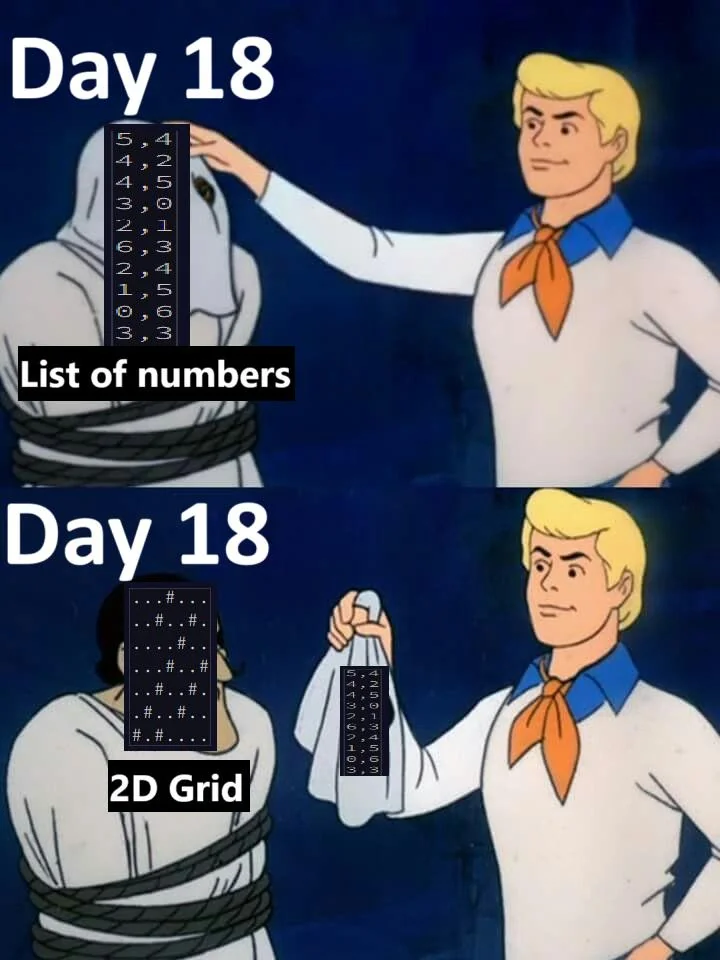The Matrix strikes back, I guess

A bit of a breather, after the challenging tasks of the past couple of days! ☺️
On day 2 I said that the task's input felt like a representation of the Matrix - I found this to be even truer for today's task, lol.
We start with a list of pairs that we're told represent an X,Y coordinate:
5,4
4,2
4,5
3,0
2,1
6,3
2,4
1,5
0,6
3,3
2,6
5,1
Starting from the top, each coordinate is the position of a byte that falls into the memory space, making it corrupted - so for example after the first 12 falling bytes we have a grid like this:
...#...
..#..#.
....#..
...#..#
..#..#.
.#..#..
#.#....
The task for part 1 is to simulate the fall of the first kilobyte, that is the first 1024 bytes, onto the memory space. Then we need to find the best path from the top-left corner to the bottom-right corner avoiding all the bytes.
SO.#OOO
.O#OO#O
.OOO#OO
...#OO#
..#OO#.
.#.O#..
#.#OOOE
Nothing too complicated for now.
We simply need to read the first 1024 lines of the input and parse the coordinates to determine where the # "obstacles" are placed.
const grid: Grid = new Map<string, string>();
for (let y = 0; y < side; y++) {
for (let x = 0; x < side; x++) {
const coord = `${x},${y}`;
if (lines.slice(0, firstCount).some((l) => l === coord)) {
grid.set(`{${coord}}`, '#');
} else {
grid.set(`{${coord}}`, '.');
}
}
}
We can then figure the best path out via a classical exploration algorithm using BFS:
function findPath(grid: Grid, end: Coord, side: number, firstCount: number) {
let currentPos = new Coord(0, 0);
const queue = new PriorityQueue<State>((a, b) => a.length - b.length);
queue.enqueue({ position: currentPos.serialize(), length: 0 });
let visited = new Set<string>();
while (queue.size() > 0) {
const { position, length } = queue.dequeue()!;
const curr = Coord.deserialize(position);
if (curr.equals(end)) {
return length;
}
if (visited.has(position)) continue;
visited.add(position);
for (let n of getNeighborCoords(curr)) {
const neighbor = n.serialize();
if (grid.get(neighbor) === '.') {
queue.enqueue({ position: neighbor, length: length + 1 });
}
}
}
return -1;
}
Moving to part 2, it is a matter of using the remaining part of the input - of course, when has anyone ever seen an AoC task where part of the input is ignored until the end? 🙄
The bytes keep falling onto our memory grid, and we're told there's a moment when all the possible paths to the end get blocked: our goal is to find the first coordinates of such byte, effectively making the end unreachable.
I could bet there is a more efficient way to achieve this, but I decided not to try and be too smart - after all my function for part 1 was already pretty fast (~90ms). My idea was simply to keep adding bytes to the grid and call the pathfinding function, until it returned -1 meaning that a path could not be found.
function findFirstBlockingByte(
lines: string[],
end: Coord,
side: number,
firstCount: number
) {
let count = firstCount + 1; // Starting from 1024 + 1
let grid: Grid = new Map<string, string>();
while (count < lines.length) {
for (let y = 0; y < side; y++) {
for (let x = 0; x < side; x++) {
const coord = `${x},${y}`;
if (lines.slice(0, count).some((l) => l === coord)) {
// Introducing a new byte to the grid with each iteration
grid.set(`{${coord}}`, '#');
} else {
grid.set(`{${coord}}`, '.');
}
}
}
const path = findPath(lines, end, side, count); // Use the function from part 1 to find a path, if any
if (path === -1) {
return lines[count - 1]; // If path not found, return the coordinates of the byte that caused the blockage
}
count++;
}
}